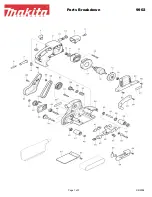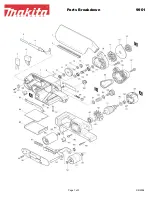
6
• When the wheel is pinched or bound tightly by the workpiece,
the wheel stalls and the motor reaction drives the unit rapidly
back toward or away from the operator.
• Kickback is the result of tool misuse and/or incorrect operating
procedures or conditions and can be avoided by taking proper
precautions as given below:
•
Maintain a firm grip with both hands on the unit and posi-
tion your body and arm to allow you to resist kickback
forces.
Kickback forces can be controlled by the operator, if
proper precautions are taken.
•
When wheel is binding, or when interrupting a cut for any
reason, release the trigger and hold the unit motionless
in the material until the wheel comes to a complete stop.
Never attempt to remove the unit from the work or pull
the unit backward while the wheel is in motion or kick-
back may occur.
Investigate and take corrective actions to
eliminate the cause of wheel binding.
•
When restarting a cut-off tool in the workpiece, check
that the wheel is not engaged into the material.
If wheel is
binding, it may walk up or kickback from the workpiece as the
tool is restarted.
•
Support large panels to minimize the risk of wheel pinch-
ing and kickback.
Large panels tend to sag under their own
weight. Support must be placed under the panel on both
sides, near the line of cut and near the edge of the panel.
WARNING: Some dust created by power sanding, sawing,
grinding, drilling, and other construction activities contains chem-
icals known to cause cancer, birth defects, or other reproductive
harm. Some examples of these chemicals are:
•
lead from lead-based paints,
•
crystalline silica from bricks and cement and other masonry
products, and
•
arsenic and chromium from chemically-treated lumber (CCA).
•
Direct sparks away from operator, bystanders or flammable
materials.
Sparks may be produced while cutting and/or
grinding. Sparks may cause burns or start fires.
• Always use side handle. Tighten the handle securely
. The
side handle should always be used to maintain control of the tool
at all times.
•
Never cut into area that may contain electrical wiring or
piping.
Serious injury may result.
• Clean out your tool often, especially after heavy use.
Dust
and grit containing metal particles often accumulate on interior
surfaces and could create an electric shock hazard.
• Do not operate this tool for long periods of time.
Vibration
caused by the operating action of this tool may cause permanent
injury to fingers, hands, and arms. Use gloves to provide extra
cushion, take frequent rest periods, and limit daily time of use.
•
Direct the Dust Ejection System (DES) away from operator
and coworkers.
Serious injury may result (Fig. 1, H).
• The label on your tool may include the following symbols. The
symbols and their definitions are as follows:
V ..........volts
A..............amperes
Hz ........hertz
W ............watts
min ......minutes
..........alternating current
....direct current
no............no load speed
........Class II Construction
..........safety alert symbol
........earthing terminal
…/min ....revolutions per minute
Causes and Operator Prevention
of Kickback
• Kickback is a sudden reaction to a pinched, bound or misaligned
wheel, wire brush or flap disc causing an uncontrolled cut-off
tool to lift up and out of the workpiece toward the operator.
E
n
g
li
sh
Summary of Contents for D28803
Page 2: ... ݏ ዐ 13 English 3 Thai 17 ...
Page 18: ...13 English 3 ไทย 17 ...







































